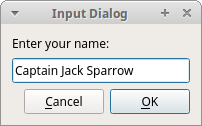标签:
对话框窗口或对话框是大多数主流GUI应用不可缺少的部分。对话是两个或更多人之间的会话。在计算机应用中,对话框是一个用来和应用对话的窗口。对话框可以用来输入数据,修改数据,改变应用设置等等。
QInputDialog提供了一个简单便利的对话框用于从用户那儿获得只一个值。输入值可以是字符串,数字,或者一个列表中的列表项。
#!/usr/bin/python3
# -*- coding: utf-8 -*-
"""
ZetCode PyQt5 tutorial
In this example, we receive data from
a QInputDialog dialog.
author: Jan Bodnar
website: zetcode.com
last edited: January 2015
"""
import sys
from PyQt5.QtWidgets import (QWidget, QPushButton, QLineEdit,
QInputDialog, QApplication)
class Example(QWidget):
def __init__(self):
super().__init__()
self.initUI()
def initUI(self):
self.btn = QPushButton(‘Dialog‘, self)
self.btn.move(20, 20)
self.btn.clicked.connect(self.showDialog)
self.le = QLineEdit(self)
self.le.move(130, 22)
self.setGeometry(300, 300, 290, 150)
self.setWindowTitle(‘Input dialog‘)
self.show()
def showDialog(self):
text, ok = QInputDialog.getText(self, ‘Input Dialog‘,
‘Enter your name:‘)
if ok:
self.le.setText(str(text))
if __name__ == ‘__main__‘:
app = QApplication(sys.argv)
ex = Example()
sys.exit(app.exec_())
例子中有一个按钮和一个单行编辑框组件。按下按钮会显示输入对话框用于获得一个字符串值。在对话框中输入的值会在单行编辑框组件中显示。
text, ok = QInputDialog.getText(self, ‘Input Dialog‘,
‘Enter your name:‘)
这一行会显示一个输入对话框。第一个字符串参数是对话框的标题,第二个字符串参数是对话框内的消息文本。对话框返回输入的文本内容和一个布尔值。如果我们点击了Ok按钮,布尔值就是true,反之布尔值是false(译者注:也只有按下Ok按钮时,返回的文本内容才会有值)。
if ok:
self.le.setText(str(text))
把我们从对话框接收到的文本设置到单行编辑框组件上显示。
 Figure: Input dialog
Figure: Input dialog
QColorDialog类提供了一个用于选择颜色的对话框组件。
#!/usr/bin/python3
# -*- coding: utf-8 -*-
"""
ZetCode PyQt5 tutorial
In this example, we select a color value
from the QColorDialog and change the background
color of a QFrame widget.
author: Jan Bodnar
website: zetcode.com
last edited: January 2015
"""
import sys
from PyQt5.QtWidgets import (QWidget, QPushButton, QFrame,
QColorDialog, QApplication)
from PyQt5.QtGui import QColor
class Example(QWidget):
def __init__(self):
super().__init__()
self.initUI()
def initUI(self):
col = QColor(0, 0, 0)
self.btn = QPushButton(‘Dialog‘, self)
self.btn.move(20, 20)
self.btn.clicked.connect(self.showDialog)
self.frm = QFrame(self)
self.frm.setStyleSheet("QWidget { background-color: %s }"
% col.name())
self.frm.setGeometry(130, 22, 100, 100)
self.setGeometry(300, 300, 250, 180)
self.setWindowTitle(‘Color dialog‘)
self.show()
def showDialog(self):
col = QColorDialog.getColor()
if col.isValid():
self.frm.setStyleSheet("QWidget { background-color: %s }"
% col.name())
if __name__ == ‘__main__‘:
app = QApplication(sys.argv)
ex = Example()
sys.exit(app.exec_())
例子中显示了一个按钮和一个QFrame。将QFrame组件的背景设置为黑色。使用颜色选择框类,我们可以改变它的颜色。
col = QColor(0, 0, 0)
初始化QtGuiQFrame组件的背景颜色。
col = QColorDialog.getColor()
这一行弹出颜色选择框。
if col.isValid():
self.frm.setStyleSheet("QWidget { background-color: %s }"
% col.name())
如果我们选中一个颜色并且点了ok按钮,会返回一个有效的颜色值。如果我们点击了Cancel按钮,不会返回选中的颜色值。我们使用样式表来定义背景颜色。
QFontDialog是一个用于选择字体的对话框组件。
#!/usr/bin/python3
# -*- coding: utf-8 -*-
"""
ZetCode PyQt5 tutorial
In this example, we select a font name
and change the font of a label.
author: Jan Bodnar
website: zetcode.com
last edited: January 2015
"""
import sys
from PyQt5.QtWidgets import (QWidget, QVBoxLayout, QPushButton,
QSizePolicy, QLabel, QFontDialog, QApplication)
class Example(QWidget):
def __init__(self):
super().__init__()
self.initUI()
def initUI(self):
vbox = QVBoxLayout()
btn = QPushButton(‘Dialog‘, self)
btn.setSizePolicy(QSizePolicy.Fixed,
QSizePolicy.Fixed)
btn.move(20, 20)
vbox.addWidget(btn)
btn.clicked.connect(self.showDialog)
self.lbl = QLabel(‘Knowledge only matters‘, self)
self.lbl.move(130, 20)
vbox.addWidget(self.lbl)
self.setLayout(vbox)
self.setGeometry(300, 300, 250, 180)
self.setWindowTitle(‘Font dialog‘)
self.show()
def showDialog(self):
font, ok = QFontDialog.getFont()
if ok:
self.lbl.setFont(font)
if __name__ == ‘__main__‘:
app = QApplication(sys.argv)
ex = Example()
sys.exit(app.exec_())
在我们的例子中,我们有一个按钮和一个表情。通过字体选择对话框,我们可以改变标签的字体。
font, ok = QFontDialog.getFont()
在这儿我们弹出一个字体对话框。getFont()方法返回字体名字和布尔值。如果用户点击了OK,布尔值为True;否则为False。
if ok:
self.label.setFont(font)
如果我们点击了Ok按钮,标签字体会被改变。
 Figure: Font dialog
Figure: Font dialog
文件对话框是用于让用户选择文件或目录的对话框。可以选择文件的打开和保存。
#!/usr/bin/python3
# -*- coding: utf-8 -*-
"""
ZetCode PyQt5 tutorial
In this example, we select a file with a
QFileDialog and display its contents
in a QTextEdit.
author: Jan Bodnar
website: zetcode.com
last edited: January 2015
"""
import sys
from PyQt5.QtWidgets import (QMainWindow, QTextEdit,
QAction, QFileDialog, QApplication)
from PyQt5.QtGui import QIcon
class Example(QMainWindow):
def __init__(self):
super().__init__()
self.initUI()
def initUI(self):
self.textEdit = QTextEdit()
self.setCentralWidget(self.textEdit)
self.statusBar()
openFile = QAction(QIcon(‘open.png‘), ‘Open‘, self)
openFile.setShortcut(‘Ctrl+O‘)
openFile.setStatusTip(‘Open new File‘)
openFile.triggered.connect(self.showDialog)
menubar = self.menuBar()
fileMenu = menubar.addMenu(‘&File‘)
fileMenu.addAction(openFile)
self.setGeometry(300, 300, 350, 300)
self.setWindowTitle(‘File dialog‘)
self.show()
def showDialog(self):
fname = QFileDialog.getOpenFileName(self, ‘Open file‘, ‘/home‘)
if fname[0]:
f = open(fname[0], ‘r‘)
with f:
data = f.read()
self.textEdit.setText(data)
if __name__ == ‘__main__‘:
app = QApplication(sys.argv)
ex = Example()
sys.exit(app.exec_())
示例中显示了一个菜单栏,中间设置了一个文本编辑框组件,和一个状态栏。点击菜单项会显示QtGui.QFileDialog(文件选择框)对话框,用于选择一个文件。文件的内容会被读取并在文本编辑框组件中显示。
class Example(QMainWindow):
def __init__(self):
super().__init__()
self.initUI()
示例基于QMainWindow组件,因为我们中心需要设置一个文本编辑框组件。
fname = QFileDialog.getOpenFileName(self, ‘Open file‘, ‘/home‘)
弹出文件选择框。第一个字符串参数是getOpenFileName()方法的标题。第二个字符串参数指定了对话框的工作目录。默认的,文件过滤器设置成All files (*)。
if fname[0]:
f = open(fname[0], ‘r‘)
with f:
data = f.read()
self.textEdit.setText(data)
选中文件后,读出文件的内容,并设置成文本编辑框组件的显示文本、
 Figure: File dialog
Figure: File dialog
这部分的PyQt5教程中,我们学习了几种对话框的使用。
标签:
原文地址:http://www.cnblogs.com/archisama/p/5454922.html